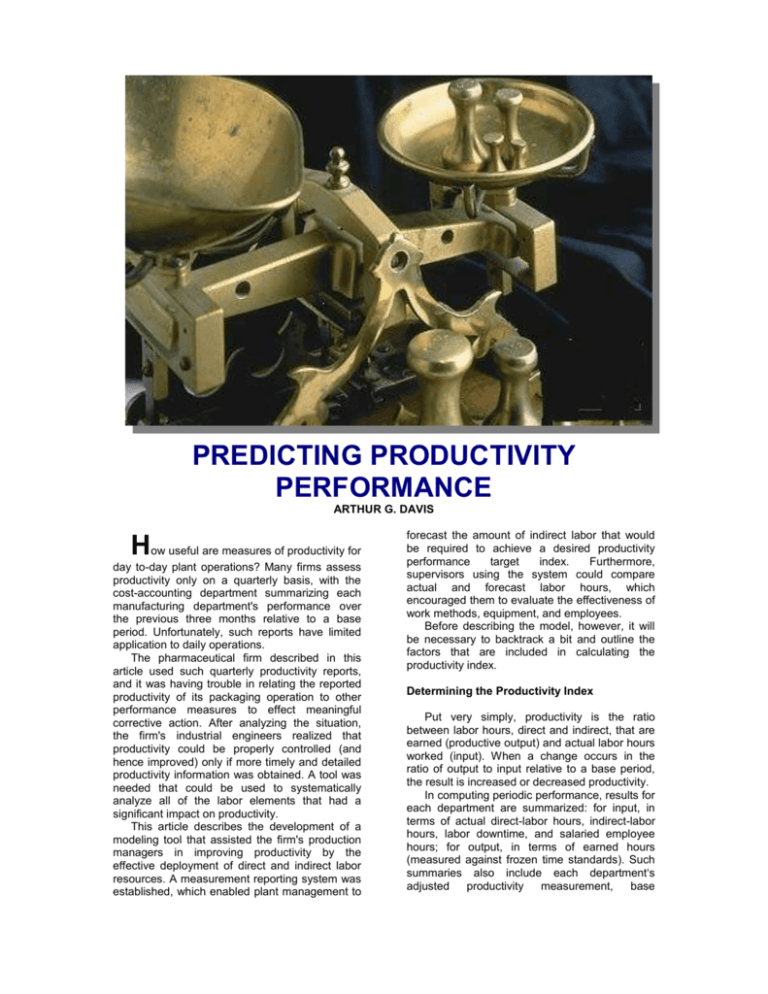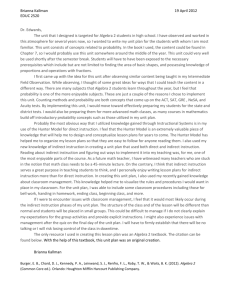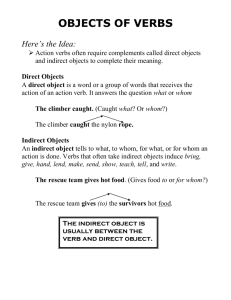Determining the Productivity Index - Institute of Industrial Engineers
advertisement

PREDICTING PRODUCTIVITY PERFORMANCE ARTHUR G. DAVIS How useful are measures of productivity for day to-day plant operations? Many firms assess productivity only on a quarterly basis, with the cost-accounting department summarizing each manufacturing department's performance over the previous three months relative to a base period. Unfortunately, such reports have limited application to daily operations. The pharmaceutical firm described in this article used such quarterly productivity reports, and it was having trouble in relating the reported productivity of its packaging operation to other performance measures to effect meaningful corrective action. After analyzing the situation, the firm's industrial engineers realized that productivity could be properly controlled (and hence improved) only if more timely and detailed productivity information was obtained. A tool was needed that could be used to systematically analyze all of the labor elements that had a significant impact on productivity. This article describes the development of a modeling tool that assisted the firm's production managers in improving productivity by the effective deployment of direct and indirect labor resources. A measurement reporting system was established, which enabled plant management to forecast the amount of indirect labor that would be required to achieve a desired productivity performance target index. Furthermore, supervisors using the system could compare actual and forecast labor hours, which encouraged them to evaluate the effectiveness of work methods, equipment, and employees. Before describing the model, however, it will be necessary to backtrack a bit and outline the factors that are included in calculating the productivity index. Determining the Productivity Index Put very simply, productivity is the ratio between labor hours, direct and indirect, that are earned (productive output) and actual labor hours worked (input). When a change occurs in the ratio of output to input relative to a base period, the result is increased or decreased productivity. In computing periodic performance, results for each department are summarized: for input, in terms of actual direct-labor hours, indirect-labor hours, labor downtime, and salaried employee hours; for output, in terms of earned hours (measured against frozen time standards). Such summaries also include each department‘s adjusted productivity measurement, base Productivity could be properly controlled (and hence improved) only if more timely and detailed productivity information was obtained. A tool was needed that could be used to systematically analyze all of the labor elements that had a significant impact on productivity. productivity, measurement, and quarterly productivity index. These elements are described in detail in this section, and their interrelationships in producing a measure of overall productivity are illustrated in Figure 1. Input. Input consists of time (in hours) contributed by direct and indirect labor (including salaried employees, plus downtime. The sum of these factors is known as total production hours. Direct labor represents the actual time expended in assembling, the finished product. In pharmaceutical operations the product fillers, inspectors, labelers, and packers are all considered assemblers, or direct labor. They are the single largest labor group whose performance is measured by comparison with predetermined standards. The term indirect labor represents all other production support personnel. In pharmaceutical manufacturing plants, indirect labor includes line supervisors, case sealers, mechanics, floor-services personnel, production office clerks, production quality assurance personnel, and administrators (e.g., the department manager, the foremen, and other departmental salaried personnel). Downtime represents lost direct-labor time Figure 1: Productivity index equation and is the result of product or equipment problems during processing. Salaried employee hours consist of the time contributed by technical and other staff support personnel. (All input factors appear in the lower half of the left-hand column in Figure 1.) Output. Output is the arithmetic result of multiplying the production rate by the labor standard established for each unit of production. To establish a consistent basis for productivity comparisons, engineered, measured, day-work standards are frozen at the beginning of each year and serve as the benchmark for an entire year's production activity. However, for accurate comparison of the current year's production activity with that of the prior year, it is necessary to eliminate the effect of the annual standards revision (i.e., the aggregate amount by which standards are tighter or looser, which generally reflects the extent to which the new standards have absorbed productivity increases from the prior year). This adjustment is made by using the standards change factor, which departments calculate when revising standards. Thus, output expressed in adjusted earned hours is obtained by computing the arithmetic product of the standards-change factor, the earned hours STANDARDS-CHANGE X FORECAST DIRECT- X EXPECTED PERFORMANCE TOTAL REQUIRED FACTOR LABOR HOURS OF DIRECT LABOR PRODUCTION HOURS = ADJUSTED BASE-YEAR MEASURE x DESIRED PRODUCTIVITY INDEX Figure 2: Formula for calculating total production hours required to attain any desired productivity index. standard, and the production rate, or work-in progress adjustment factor. (All output factors appear in the upper half of the left-hand column in Figure 1.) The Productivity Index. Dividing adjusted earned hours (output) by total production hours (input) yields an adjusted productivity measure, which is divided by the base-year adjusted productivity measure to obtain the quarterly productivity index. Thus, any improvement or decline in productivity during the current period is reflected against the base period (usually the previous year). After all manufacturing departments calculate this index, results are then combined to determine an overall productivity index for the business unit (see Figure 1). Developing the Productivity Forecast Model We began developing our predictive model in the pharmaceutical firm's packaging operation by closely examining the individual factors involved in computing the productivity index. Instead of computing that index, however, we recombined the elements to determine the total manufacturing hours needed to achieve any desired productivity index. If we are given a forecast for direct-labor hours to be worked, along with an index of the anticipated performance efficiency of that direct labor, we can compute total production hours required to attain any desired productivity index by using the following productivity index equation: total production hours would equal the product of the standards-change factor, forecasted Year and Month Year 1 October November December Year 2 January February March April May June July August September Direct Labor Hours (D.L.) Total Indirect Labor Hours (I.L.) 15,547.3 12,120.0 11,962.2 13,366.6 12,361.5 12,017.9 13,602.1 10,053.1 9,516.2 10,818.6 9,166.7 8,165.4 D.L./I.L. Line Supervisor Hours (L. S.) 9,271.0 7,129.4 6,886.7 1.68 1.70 1.74 7,953.3 6,876.3 7,020.6 8,346.8 5,808.9 5,947.0 6,935.7 5,725.3 5,313.4 1.68 1.80 1.71 1.63 1.73 1.60 1.39 1.60 1.54 direct-labor hours, and expected performance of those direct-labor hours, divided by the product of the adjusted base-year measure and the productivity index desired (see Figure 2). Total production hours comprise direct-labor hours, indirect-labor hours, downtime hours, and salaried employee hours. (Because of its importance, we also separated quality assurance hours from total indirect labor for our study.) To progress toward the desired productivity index, the production manager must calculate the time contribution of each of these elements to the total production hours; knowledge of total hours alone is insufficient for effecting meaningful change. Indirect labor, downtime, and quality assurance elements also influence productivity performance significantly, yet these factors are often overlooked. We analyzed the key indirect areas of the packaging operation in order to understand the particular characteristics of each as related to direct labor. The results of this study, a part of which is shown in Table 1, revealed that the various elements of indirect labor were proportional to direct labor and thus displayed consistent proportional relationships to total production hours. Ratios of direct labor to indirect-labor categories and to downtime were derived by analyzing past performance; we also noted where the highest and lowest ratios of direct to indirect labor occurred. For most of the indirect categories we studied, the range between the highest (most optimistic) and lowest (most pessimistic) ratios generally followed a normal distribution. To establish the validity of these Quality Assurance Hours (QA) D.L./QA D.L./L.S. Mechanic Hours (Mech.) D. L. Mech. 2,336.1 1,760.3 1,684.3 6.66 6.89 7.10 2,611.8 2,078.7 2,059.9 5.95 5.83 5.81 1,300.0 1,560.5 1,437.2 11.96 7.77 8.32 2,031.4 1,615.1 1,793.3 1,993.3 1,213.6 1,358.7 1,434.6 1,204.9 1,122.5 6.58 7.65 6.70 6.82 8.28 7.00 7.54 7.61 7.29 2,370.7 2,194.6 2,028.3 2,453.2 1,694.9 1,721.2 2,034.3 1,867.4 1,647.4 5.64 5.63 5.93 5.54 5.93 5.53 5.32 4.91 4.97 1,592.2 1,587.9 1,420.6 1,602.9 971.5 1,013.8 1,298.7 1,261.6 1,033.0 8.40 7.78 8.46 8.49 10.35 9.39 8.33 7.27 7.92 Table 1: Sample of the summary data on the relationships between direct labor and various indirect-labor elements. observable ratio relationships, statistical testing was employed. It supported our initial findings. Highest Lowest Indirect-Labor Standard Ratio Ratio Category Ratio Attained Attained Line supervisors 7.00 8.28 6.58 Mechanics 5.76 5.95 4.91 Quality assurance 9.00 11.96 7.27 Downtime 12.00 15.94 9.55 Case sealers 36.50 40.41 33.10 Floor services 19.00 20.15 16.04 Bulk stock handlers 19.00 20.77 16.53 Group leaders 36.74 42.71 33.81 Coordinator, timekeeper, instructor 24.00 30.77 19.96 Secretary, scheduler, clerk 18.10 19.17 17.25 Table 2: Ratios of direct to indirect labor hours. By determining the range of ratios, we then established standards or benchmarks, in the form of ratios of direct to indirect labor. For each category of indirect labor, the benchmark was set at, or slightly above, the mean, depending on the distribution of the data. After these standards were established, as shown in Table 2, the relationship of each indirect variable to total production hours was calculated using regression analysis. With the relationships among all the elements in place, we then adapted the equation to a computer program, which calculated the maximum allowable hours for each indirect-labor element. We were then able to compute the appropriate indirect labor requirements to achieve a desired productivity level when supplied with a projection of the direct labor input and its anticipated performance efficiency. Applying the Productivity Model Our model could now enable supervisors to play "what if" games, testing the productivity consequences resulting from different combinations of direct and indirect labor. Although this model was initially applied to the plant's packaging department, a decision-making procedure soon developed that required the involvement of all supervisory and plant management personnel. The procedure begins by determining the direct labor requirements (in hours) for the following day. Together, the coordinator, scheduler, and department manager make a projection in conjunction with production control. After direct-labor requirements are established, the coordinator informs the industrial engineering department of the expected number of direct-labor hours to be worked, the anticipated level of performance efficiency against the frozen standard, and the productivity index goal for the day. Computer to determine both the commensurate labor requirements for all indirect-labor categories and the appropriate allowances for downtime and quality assurance in turn processes this information. The indirect-labor requirements are then communicated to the production department's scheduler and timekeeper, to be used as a guide in determining the day's final crewing requirements for both direct and indirect labor. Indirect-labor requirements are an indicator of where to place emphasis in optimizing the contributions of all personnel and thereby achieving the desired productivity index. The performance of direct and indirect labor is then evaluated against established targets for both labor types by comparing the forecast hours required with actual hours worked. Such an evaluation reinforces to supervisors the importance of assessing the effectiveness of various work methods, equipment, and employees. In daily morning conferences, the department manager, key supervisory personnel, and a representative of industrial engineering assess the previous day's performance, highlight problem areas for correction, and review the current day's objectives. To complete the system and ensure performance follow-up, a large progress chart is displayed in a conspicuous area of the plant. (Figure 3 is a simplified version of the chart.) This chart lists those labor elements that have had the greatest impact on productivity and highlights categories in which performance exceeded the forecast thereby emphasizing to all personnel the importance of productivity and the various contributions of each group. In the budgetary process, the productivity forecast model has been used in the areas of short- and long-range head-count planning. Product forecasts by marketing and Production control can be readily translated into indirect and direct labor requirements. For example, when production activity was projected to decline as a result of management-mandated inventory reduction goals, the need to reduce indirect-labor resources commensurate with direct labor was anticipated. Transfers, loans, and other contingencies were arranged in, sufficient time so that these labor reductions could occur in proper order. Previously, it had been difficult to effectively coordinate indirect-labor requirements so that they would be commensurate with forecasted production. Cost estimating is another area of application, particularly when indirect-labor costs are assessed. Such data are easily obtained once the direct-labor standard is computed and the production forecast is known. Forecasted direct hours are calculated, and estimates of performance and the productivity index can then be accessed to compute commensurate indirect-labor resource requirements. When applying the forecasting model, one should remember that the various ratios of any direct-labor category might change over a period of time due to ongoing, subtle changes in methods, equipment, and personnel. An annual review of the standard ratios for indirect labor should therefore be conducted. Art Davis is principal of the Davis Group, a Chicago area consultancy specializing in business process improvement and total quality. He has delivered many training programs in Six Sigma for Motorola, Caterpillar, ITW, Litelfuse and other firms. For more information, call 847.685.9820.







